Study on the photoluminescence from nano
advertisement
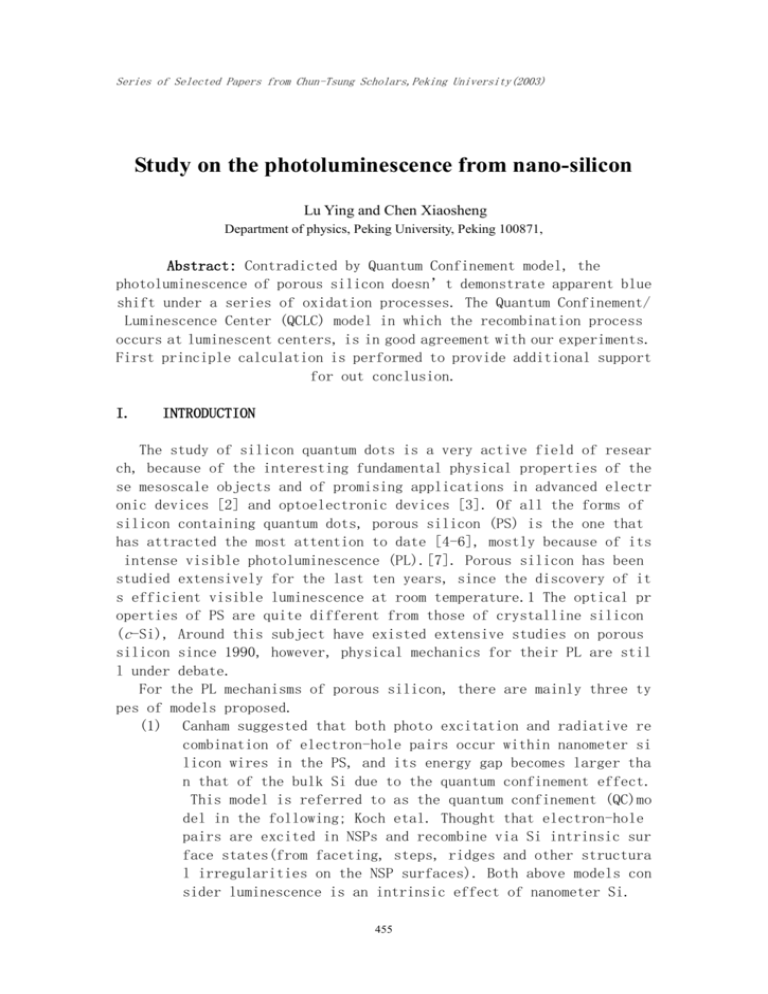
Series of Selected Papers from Chun-Tsung Scholars,Peking University(2003) Study on the photoluminescence from nano-silicon Lu Ying and Chen Xiaosheng Department of physics, Peking University, Peking 100871, Abstract: Contradicted by Quantum Confinement model, the photoluminescence of porous silicon doesn’t demonstrate apparent blue shift under a series of oxidation processes. The Quantum Confinement/ Luminescence Center (QCLC) model in which the recombination process occurs at luminescent centers, is in good agreement with our experiments. First principle calculation is performed to provide additional support for out conclusion. I. INTRODUCTION The study of silicon quantum dots is a very active field of resear ch, because of the interesting fundamental physical properties of the se mesoscale objects and of promising applications in advanced electr onic devices [2] and optoelectronic devices [3]. Of all the forms of silicon containing quantum dots, porous silicon (PS) is the one that has attracted the most attention to date [4-6], mostly because of its intense visible photoluminescence (PL).[7]. Porous silicon has been studied extensively for the last ten years, since the discovery of it s efficient visible luminescence at room temperature.1 The optical pr operties of PS are quite different from those of crystalline silicon (c-Si), Around this subject have existed extensive studies on porous silicon since 1990, however, physical mechanics for their PL are stil l under debate. For the PL mechanisms of porous silicon, there are mainly three ty pes of models proposed. (1) Canham suggested that both photo excitation and radiative re combination of electron-hole pairs occur within nanometer si licon wires in the PS, and its energy gap becomes larger tha n that of the bulk Si due to the quantum confinement effect. This model is referred to as the quantum confinement (QC)mo del in the following; Koch etal. Thought that electron-hole pairs are excited in NSPs and recombine via Si intrinsic sur face states(from faceting, steps, ridges and other structura l irregularities on the NSP surfaces). Both above models con sider luminescence is an intrinsic effect of nanometer Si. 455 Series of Selected Papers from Chun-Tsung Scholars,Peking University(2003) (2) The luminescence from PS was attributed to some luminescence materials other than pure Si, such as: siloxene, SiHx compl exes, polysilanes or SiO2, rather than intrinsic property of nanometer Si. (3) Qin and Jia have proposed the quantum confinement/luminescen ce center(QCLC) model, for the oxidized PS, it was suggested that photo-excitation of electron-hole pairs occurs in NSPs, however, most electrons and holes tunnel from NSPs into the luminescence centers(LCs)in SiOx layers surrounding the NSP s and radiatively recombine in the LCs. QC model can explain the emission photon energy of photo luminesce nce in the range of visible light. But, serious contradictions exist between its predictions and a number of experimental results.[8-11]. Fig1 shows the discrepancy between theory and PL predicted bandgaps o f PS. FIG.1. Complication of optical bandgaps of silicon crystallites and porous samples obtained from optical absorptions (unfilled symbols) and luminescence (filled symbols). The dashed and continuous lines represent the calculated values with and without the excitonic correction The contradiction can be resolved easily by invoking the quantum c onfinement–luminescence center (QCLC) model by G. G. Qin [12,13]. Th e main point of view of this model is that the photo-excitation of th e carriers does take place in the nc-Si to cause the optical excitati on in an energy range much bigger than the bulk Si band gap. The radi ative recombination center of electron–hole pairs inside the nc-Si i s smaller than that outside the nc-Si, so that most carriers produced inside the nc-Si may tunnel into the surrounding SiO2 layer and then recombine to emit visible light through various luminescence centers (LCs) (point defects or impurities) which are located in the SiO2 la 456 Series of Selected Papers from Chun-Tsung Scholars,Peking University(2003) yer. [14,15] FIG.2. Schematic illustration of the luminescence process that electron-hole pairs are excited in nanoscale silicon, and then recombine at luminescence centers to emit visible light. The left side denotes the main LCs are some adsorbents on nanoscale Si particles surfaces for as-prepared PS, while the right side denotes that the main LCs are some types of LC in SiOx layers for fully oxidized PS. The purpose of our work is mainly to testify the reasonability of QCLC model through the investigation of the luminescent properties o f PS and through first principle calculation. II. Experiment The PS sample was prepared by electrochemical etching of p-type, boron-doped, 20 Ω.cm, 100 oriented crystal of Si wafers. Aluminum film was deposited on the back of the sample to improve the uniformity of the anodic current. The electrolyte solution is a mixture of hydrofluoric (HF):ethanol:H2O2 =2:1:2 by volume.. Anodization was carried out in a plastic cylinder using 150 mA/cm2 current for 2 to 20 min, the cathode is made of Pt, and anode is the wafer itself. After etching, the silicon surface was rinsed with water. The PS layer exhibited intense orange PL to the naked eye under 355-nm UV light after aging for a few days.Fig3 is the systemic layout of the chemical etching process. 457 Series of Selected Papers from Chun-Tsung Scholars,Peking University(2003) FIG.3. The production of porous silicon. To measure PS sample’s radiative lifetime is an important way to understand the optical process in PS. The as-prepared PS is taken care to be dispersed in water, the lifetime of PS is measured with frequency domain method. The modulation frequency varies from 0 to 250 Mhz with excitation wavelength of 360 nm. In ambient condition, the as-prepared PS sample will be oxidized gradually, the process will usually takes months to stabilize the lum inescence of PS. Rapid thermal oxidation (RTO) is used to accelerate and strengthen the process. RTO is performed in 900 oC for 30 to 120 m inutes with O2 current of 100ml/min as the source of oxygen (Fig 5). The oxidation process can by also performed at ambient temperature by immerge the as-prepared porous silicon wafers in HF:H2O2=1:1 solution for different times, then take by care the samples to measurement im 458 Series of Selected Papers from Chun-Tsung Scholars,Peking University(2003) mediately to avoid the oxidation of air (Fig 6). PL is measured by a spectrograph containing a xenon lamp with a g rating monochromator set at 360 nm. The measurement condition is iden tical through a series of experiment. FIG.5. PL spactra by RTO. a: as prepared, b: for 30 minutes, c: for 60 minutes, d: for 90 minutes, e: for 120 minutes. Excitation wave length:360 nm FIG.6. PL spectra by chemical oxidation performed in H2O2:HF=1:1 solution. a: as prepared, b: for 30 seconds, c: for 60 seconds, d: for 90 seconds, e: for 120 seconds and etc. The PL spectra of PS samples are shown in Figs, In fig.5, it’s cl ear that thermal oxidation process induced no visible blue-shift, but in combination with great reduction of the intensity of PL. in fig.6, the chemical oxidation process, though causing minor blue-shift in P L spectra, still demonstrates a decrease in the intensity of PL as th e increasing of time in oxidation. According to the statements of QC model, the energy of a phonon are expected to vary proportionally to 1/d2, where d is the size of the quantum system from the simple parti cle-in-box model[16](see figure 7), Since continued oxidation result 459 Series of Selected Papers from Chun-Tsung Scholars,Peking University(2003) s in the decrease of the particle size until full oxidation is achiev ed, the lack of PL blue shift under these conditions rules out the si mple quantum confinement model for the emission process. The above ph enomena can be explained easily by QCLC model, which predicts that fo r a large nano-particle (eg. >2 nm), the recombination process mainly occurs at the luminescence centers on particle’s surface. The oxid ation process has minor influence on the density of luminescence cent er covering the nano-particles, therefore no strong blue-shift can be expected according to QCLC model. FIG.4. the change of energy gap (Eg) with the diameter of si nanowire. In our simulation, the energy gap (Eg) is in proportion to 1/d. III. Simulation The computational method is an ab initio total energy pseudopotent ial technique within the density fuctional theory DFT in the generali zed gradient approximation GGA as implemented in the ABINIT code. Two theoretical models have been proposed to investigate the prope rties of this material: isolated Si quantum wires and columnar pores. Semi-empirical and first-principles local-density calculations have been performed within the first model, while the second one is not so widely used, although it has the advantage of being able to incorpor ate the inter connectivity of the system[17], in the flowing discussi ons, the first model is chosen as the simulation layout in that both current theoretical study and simulations suggest that additional con finement in the third direction of a 2D wire model doesn’t lead to q ualitative new features [1](p. 1300) .thus Si-quantum wire model is m ore realistic to the theoretical approach to porous silicon. Differen t surface circumstance of the Si nanowire has been tested. Note that we assume that crystalline order is preserved in the Si nanowire, surface relaxation effect is omitted. 460 Series of Selected Papers from Chun-Tsung Scholars,Peking University(2003) FIG.10. system layout. A unit cell of bulk silicon is taken to repeat infinitively in z direction to simulate a silicon nanowire, whose surface is passivated by oxygen or not. Fig11 is the result of first principle calculation, band structure and density of states (DOS). A direct band gap of 1.2 eV at Γ point is observed in the bare nanowire; in the lightly passivated (Si:O=3: 1) nanowire, the direct band gap is reduced to 0.7 eV, in addition, no visible band gap is observed in the heavy passivated (Si:O=1.5:1) Si nanowire. The result is qualitative in agreement with the experime ntal result and the prediction of QCLC model, in the sense that accor ding to our simulation, it is oxygen that, by reducing the energy gap ( or the distance between LUMO and HOMO), red-shifts the PL spectra and balances the blue shift induced by the reduction of diameter of n anowire in RTO and other oxidation processes. FIG.11. Band structure and corresponding density of state (DOS). A1: band structure of a bare si nanowire in (001), a direct band gap of 1.2 eV is observed at k=0,. A2: corresponding DOS. B1: band structure of a lightly passivated (Si:O=3:1) si nanowire, a direct band gap of 0.7 eV is observed at k=0 in (001), B2:corresponding DOS. C1:band structure of a heavily passivated (Si:O=1.5:1) si nanowire in (001), no visible band gap can be observed. C2: corresponding DOS 461 Series of Selected Papers from Chun-Tsung Scholars,Peking University(2003) Acknowledgement We are grateful to Mr. G.G.Qin for instructive discussion, and Mr. G.Z.Ran for critically reading the paper. we also acknowledge support from “Jun Zheng” fund for providing us opportunity to do the research. Reference 1 Stephanie M. Reimann and Matti Manninen. Rev. Mod. Phys, 74, 1283 (2002) A. Fowler, Phys. Today 50, No. 10, 50 (1997). 3 K. D. Hirschman, L. Tsybeskov, S. P. Duttagupta, and P. M. Fauchet, Nature (London) 3 84, 338 (1996). 4 A. G. Cullis, L. T. Canham, and P. D. J. Calcott, J. Appl. Phys. 82, 909 (1997). 5 P. M. Fauchet, J. Lumin. 70, 294 (1996). 6 R. T. Collins, P. M. Fauchet, and M. A. Tischler, Phys. Today 50, No. 1, 24 (1997). 7 M. V. Wolkin, J. Jorne, and P. M. Fauchet. Phys. Rev. Lett. 82, 197 (1999) 8 J. Lin, L. Z. Zhang, Y. M. Huang, B. R. Zhang, and G. G. Qin, Appl. Phys. Lett. 64, 3282 (1994). 9 A. J. Kontkiewicz et al., Appl. Phys. Lett. 65, 1436 (1994) 10 S. M. Prokes and O. J. Glembocki, Phys. Rev. B 49, 2238 (1994.) 11 G. G. Qin, H. Z. Song, B. R. Zhang, J. Lin, J. Q. Duan, and G. Q. Yao, Phys. Rev. B 54, 2548 (1996). 12 G. G. Qin and Y. Q. Jia, Solid State Commun. 86, 559 (1993). 13 G. Qin and G. G. Qin, J. Appl. Phys. 82, 2572 (1997). 14 G. Qin, G. G. Qin and S. H. Wang. J. Appl. Phys. 85, 6738 (1999) 15 A. G. Cullis, L. T. Canham and P. D. J. Calcott. Appl. Phys. Rev. 82, 909 (1997) 16 V. Lehmann and U. Gosele, Appl. Phys. Lett, 58, 856 (1991) 17 E. Va´zquez, and J. Tagu¨en˜a-Martý´nez . J. Appl. Phys. 91,3085 (2002) 2 作者简介: 陈晓升,男,1982 年 1 月出生于江苏省张家港市,2000 年从梁丰高级中学 获国际物理奥赛金牌保送进入北京大学物理学院。 吕莹, 男, 1982 年 3 月出生, 2000 年从天津市南开中学毕业,同年获得 31 届国际物理奥林匹克竞赛金牌, 并被保送北大物理系. 感悟与寄语: 进入大学以后,许久以来,不论是理论的还是实验的,大学本科规定课程的 大部分知识对我们来说,是接受一种既定的知识,从某种意义上来说,从书本上、 老师口中得来的这些知识只是工具,是劳作的资本,“ 政基金”的本科生科研, 无疑是给了我们一个机会,让我们可以运用现有的知识,在导师的带领下,体会 科研中的探索精神。回顾这一年的工作,收获最大的,该是体会了一种方法,一 种做科研的方法,“严谨”,这个由秦老师多次提到的词,让我对科研有了更深更 462 Series of Selected Papers from Chun-Tsung Scholars,Peking University(2003) 深切的体会。搞自然科学的人必须严谨,研究的每一个过程必须清晰,就物理来 说,对于每个研究的问题,首要的,是弄清楚它的物理意义,当中涉及的每一个 物理过程,这些是基础,搞清楚了这些,才能着手下一步的工作。当然,搞科研, 还有一个重要的因素是兴趣,题目的选取,要尽量往自己喜欢的方向靠拢,这样, 会让自己最大限度地发挥出主观能动性,参与到实验中去。衷心希望更多的同学 在本科期间能将自己学到的知识通过这样那样的途径,得到历练。 指导教师简介: 秦国刚,教授、院士。1956 年毕业于北京大学物理系,1962 年研究生毕业 于该系固体物理方向。长期从事半导体材料物理研究。他与合作者在国内外发表 论文 220 余篇(其中 SCI 收录 140 余篇),其中的 88 篇论文被他人索引共 530 余 次。自 1991 年以来他以主要精力从事硅基发光研究。他被邀参与两本国际多孔 硅权威性专著的撰写:为 Porous Silicon (World Scientific, Singapore 1994) 撰写 Photoexcitation and luminescence Processes in Porous Silicon。为 Canham 主编的 emis 丛书之一 Properties of Porous Silicon(Inspect, London, 1997),撰写 Ultraviolet Photoluminescence from Porous Silicon。曾获国 家教委(教育部)科技进步一等奖和二等奖各一次,科学院自然科学二等奖一次。 他作为本研究集体的代表,其“氧化多孔硅和纳米硅与纳米锗镶嵌氧化硅发光” 研究成果获 2000-2001 年度中国物理学会叶企荪物理奖。 463
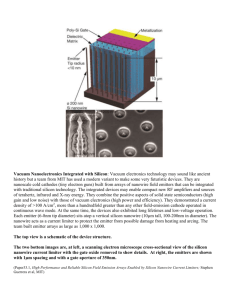

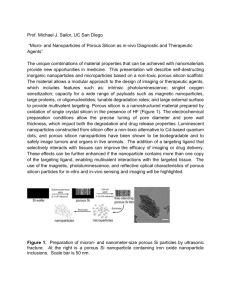

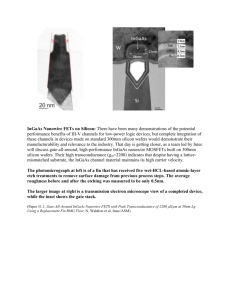
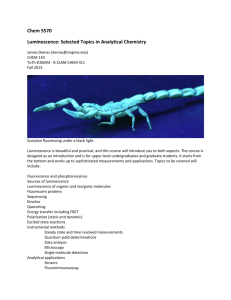

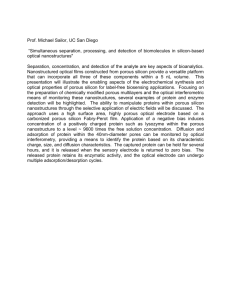
![[1]. In a second set of experiments we made use of an](http://s3.studylib.net/store/data/006848904_1-d28947f67e826ba748445eb0aaff5818-300x300.png)